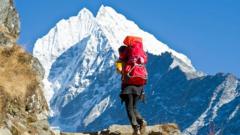Nepal is gearing up to boost tourism in its remote regions by offering free climbing access to 97 of its Himalayan peaks for the next two years. This initiative is launched amidst a significant rise in permit fees for climbing Mount Everest, which will now cost climbers $15,000 (£11,170) during peak season starting September—the first hike in almost a decade. The change aims to shift focus onto unexplored attractions in Nepal and alleviate pressure from its crowded icon, allowing climbers to seek alternative rewards high in the majestic mountains.
Last year, climbing fees brought in a substantial $5.9 million, with Everest contributing more than 75% of that revenue. The waiving of fees applies specifically to peaks located in Nepal's impoverished Karnali and Sudurpaschim provinces, climbing heights ranging from 5,970m (19,590 ft) to 7,132m. Himal Gautam, director of Nepal's Tourism Department, believes that this initiative will help create jobs and strengthen local economies.
However, it's unclear if there will be improvements in infrastructure to handle an expected influx of travelers to these remote areas, where access has been historically challenging. In the past two years, only 68 climbers have ventured into these 97 peaks compared to the 421 permits issued for Everest in 2024. The Supreme Court of Nepal has sought to limit the number of permits issued for Everest, emphasizing that mountain capacities should be respected.
As climbing dynamics shift, a proposed law suggests that individuals wishing to summit Everest must first have ascended a mountain over 7,000 meters in Nepal, positioning the newly accessible peaks as ideal training grounds for aspiring climbers. The Nepalese government hopes this move will ensure sustainable tourism growth, benefiting both the economy and the stunning natural landscapes of the far-western region.
Last year, climbing fees brought in a substantial $5.9 million, with Everest contributing more than 75% of that revenue. The waiving of fees applies specifically to peaks located in Nepal's impoverished Karnali and Sudurpaschim provinces, climbing heights ranging from 5,970m (19,590 ft) to 7,132m. Himal Gautam, director of Nepal's Tourism Department, believes that this initiative will help create jobs and strengthen local economies.
However, it's unclear if there will be improvements in infrastructure to handle an expected influx of travelers to these remote areas, where access has been historically challenging. In the past two years, only 68 climbers have ventured into these 97 peaks compared to the 421 permits issued for Everest in 2024. The Supreme Court of Nepal has sought to limit the number of permits issued for Everest, emphasizing that mountain capacities should be respected.
As climbing dynamics shift, a proposed law suggests that individuals wishing to summit Everest must first have ascended a mountain over 7,000 meters in Nepal, positioning the newly accessible peaks as ideal training grounds for aspiring climbers. The Nepalese government hopes this move will ensure sustainable tourism growth, benefiting both the economy and the stunning natural landscapes of the far-western region.






















